- Administrator
- Albums and Singles
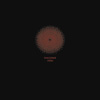 In some ways this work is reminiscent to the Gunter Muller disc I covered last year as it presents a percussionist using his instruments in a way that mostly does not resemble drums or anything usually associated with the style. Instead it is heavily processed and treated to take on an entirely different quality and tone. It is a very interesting work, but the presentation is almost a bit too familiar.
In some ways this work is reminiscent to the Gunter Muller disc I covered last year as it presents a percussionist using his instruments in a way that mostly does not resemble drums or anything usually associated with the style. Instead it is heavily processed and treated to take on an entirely different quality and tone. It is a very interesting work, but the presentation is almost a bit too familiar.
It isn't entirely impossible to recognize some of what is traditionally associated with drums, sonically, at least, through this album. There are some traditional drum skin rattles smattered across here and there, but not too obvious unless the effort is made to hear them. Instead there is significantly more incidents where the sound is shaped into a more dense collage, like the dense roar that is the title track which eventually resembles a massive stampede of wildebeests moving across the plains. "Drgacze" is a notable contrast to the verdant visuals of the aforementioned track, the rattles come across like an industrial jackhammer before a metal percussion section comes in that sounds like a gamelan band being physically assaulted during their performance.
The tracks in which the sounds are even less identifiable are, in my opinion, more fascinating. The rather simplistic, in a structural capacity at least, "O_vbrdub," is a slow moving mudslide of organic sounds: a thick and sticky slow motion avalanche of textual sound. At the same time, "Sink" rests upon a bed of harsh siren like loops and scraping high end rattles of noise alongside a digital micro-sample buzzing and cutting, slicing metallic sounds.
The album ends with the most dissonant tracks. "Aigua Per A" features a violent buzzing noise that wouldn't have been out of place on a peak-era Whitehouse album with sustained digital micro-sample stuttering and mechanical elements. The disc closes on an especially dark note, the low end rumble with clattering cymbals of "Diners Per N," which is nothing but sinister and looming
Musically, it is a very unique experiment that is extremely diverse without being the work of a dilettante. While it might seem to lack any specific thematic cohesion or overarching structure, it remains consistently interesting through its duration. The packaging, however, is coming from a much less unique background. While it is attractive, the matchbook folding cover is very, very close to the Utech label's Arc series of discs from last year, right down to the die cut black sleeve that holds the CD. I'm sure this something done for cost effective reasons, it is too similar to the Utech stuff to go unmentioned. Again, no slight against the artist for this, but it had to be said. Sorry.
samples:
Read More
- Administrator
- Albums and Singles
Not that Adamson is aping anyone on this record; you can hear strains of Elvis or Jacques Brel, but it remains unmistakably Barry Adamson. Just one track, "Shadow Of Death Hotel," manages to seamlessly stitch together the sounds of a guitar and flute from a '70s funk song, Jackie Mittoo's keyboards, the horn section from the Mike Hammer
theme, and some Butch-Vig-ish fuzzed out guitars. By the next track, he's on to channeling Al Green. Other touchstones include Curtis Mayfield, Leonard Cohen, Serge Gainsbourg, and more.
Barry premiered this album in full at the recent London Jazz Festival (the least "jazz" thing there, by far), headlining two sold-out nights at the Queen Elizabeth Hall. The album went over amazingly. Barry Adamson will be in New York City and available for press from February 28th to March 2nd.
Release dates:
Digital (worldwide): March 17th, 2008
CD/LP (UK/EU): March 31st, 2008
CD/LP (US/Australia): April 22nd, 2008
Tracklisting:
1. The Beaten Side Of Town
2. Straight 'Til Sunrise
3. Spend A Little Time
4. Shadow Of Death Hotel
5. I Could Love You
6. Walk On Fire
7. Flight
8.Civilization
9. People
10. Psycho_Sexual
Tour dates:
03/31 Oxford, Academy, UK
04/01 Edinburgh, Voodoo Rooms, UK
04/02 Glasgow, Oran Mor, UK
04/04 Manchester, Lowry Theatre, UK
04/05 Nottingham, Rescue Rooms, UK
04/06 Bristol, Thekla, UK
04/07 Berlin, Privatclub, Germany
04/09 London, Pigalle Clu, UK
04/10 Brighton, Komedia, UK
04/12 Paris, Noveau Casino, France
06/18 Brisbane, The Zoo, Australia
06/19 Melbourne, The Corner Hotel, Australia
06/20 Sydney, The Factory, Australia
06/21 Perth, The Bakery Artrage Complex, Australia
Read More
- Administrator
- Albums and Singles
CD / 2x10 inch LP / 2x10 inch LP picture disc
From Autumnal to Vernal Equinox, this is the Death In June Winter
tree. Stripped bare, but for thirteen of its branches. But they are
as strong as ever, and with thirteen glasses and one last toast, this
new album captures the true essence of Death In June, again setting
new standards in its self-created genre. Let the Blackbirds kiss you
and may The Rule Of Thirds dictate your life.
NER/NERUS, in association with Soleilmoon, is proud to announce the
first new Death In June studio album in more than three years. The CD
is presented in an embossed softpak with 16 page lyric book. The
double 10 inch vinyl edition comes in two versions: An edition of
1500 copies in black vinyl, and a very limited edition of 500 picture
discs. Both are packaged in an embossed gatefold sleeve with a large
fold-out poster with lyrics and photo.
Track Listing:
THE GLASS COFFIN / FOREVER LOVES DECAY / JESUS, JUNK AND THE
JURISDICTION / IDOLATRY / GOOD MOURNING SUN / THE PERFUME OF
TRAITORS / LAST EUROPA KISS / THE RULE OF THIRDS / TRULY BE / THEIR
DECEPTION / MY RHINE ATROCITY / TAKEYYA / LET GO.
Read More
- Administrator
- Albums and Singles
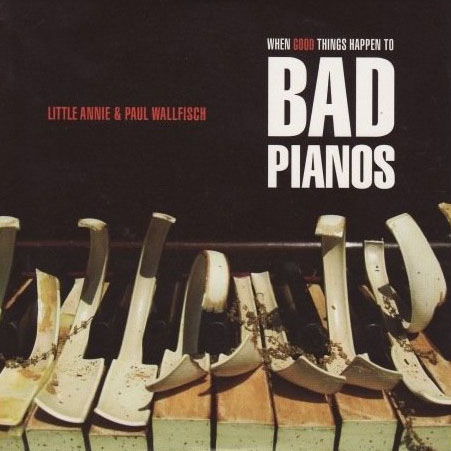 Having had the privilege and pleasure to catch this dazzlingly deviant duo in concert on several occasions this decade, this album of covers seemed all but inevitable. Here, much to my delight, the diminutive diva and her frizzy-haired ivory tickler present some of these practiced though never before released songs on disc for the very first time.
Having had the privilege and pleasure to catch this dazzlingly deviant duo in concert on several occasions this decade, this album of covers seemed all but inevitable. Here, much to my delight, the diminutive diva and her frizzy-haired ivory tickler present some of these practiced though never before released songs on disc for the very first time.
Durtro Jnana
Mixing what might be called standards with more contemporary pop fare, When Good Things Happen to Bad Pianos re-imagines the established originals through Paul Wallfisch's spare, smoky piano arrangements and Little Annie Anxiety Bandez's uniquely experienced and moving vocal tone. The cover artwork depicting a severely neglected and surely abused piano may be striking, but this menacing exterior does no justice to the delicate, exquisite artistry enclosed within. Annie sounds perfectly at home on comfortable cuts like the Barbara Streisand staple "The Summer Knows" as well as the excessively interpreted "Yesterday When I Was Young" and "Song For You." Yet with Wallfisch at her side, she regularly finds ways to challenge herself while paying tribute to the songs she so clearly loves. After listening to this album, I cannot fathom a more suitable singer to tackle the Mark Knopfler penned Tina Turner classic "Private Dancer" than Annie. Matching and, at times, even exceeding Turner's distinct delivery, she evokes the desperation and disgust of the lyrics, all without going over the top even for a second.
Despite my learned familiarity with her repertoire, Annie still manages to deliver a surprise or two. She sounds downright bluesy on Candi Stanton's 1978 disco hit "Victim," which features guitar work and backing vocals from New York music mainstay Kid Congo Powers. Of course the biggest shocker has to be the restrained cover of U2's "I Still Haven't Found What I’m Looking For." Though the overplayed original continues to haunt a pre-programmed Clear Channel station near you, Wallfisch ascetically hones in on the melody buried under all that production work to lay a base for Annie to croon and riff over.
Although not as compelling as the incomparable Songs from the Coal Mine Canary, the magnificent 2006 album of originals, the immensely enjoyable When Good Things Happen to Bad Pianos hardly classifies as a stopgap release. Unlike other artists who toss out covers records for less than legitimate purposes, these cherished interpretations are just as much a part of the Little Annie and Paul Wallfisch experience as their own material.
Samples:
Read More
- Matthew Amundsen
- Albums and Singles
With lush production that often strays into gorgeous territory, this is a pleasant album that won’t ruffle any feathers. Fronted by a horn, the group seems more like a jazz combo than a rock band. They also use some lightly processed effects and electronics but these are mixed unobtrusively into the ambience without ever coming to the fore. My only complaint is that while the band are adept musicians, their songwriting tends to relegate the music to the background because nothing ever jumps out as being terribly memorable. It is the sort of thing I could listen to all day yet be able to recall very little of afterwards. The songs have their own trajectory, but the payoff is rarely dramatic enough to elicit any emotional satisfaction.
On the other hand, the remixes add some distinction to the material. Four Tet's remix of "Gardening, Not Architecture" lends urgency to the rhythm and integrates high-pitched bleeps into the mix that give the song its distinctive character. Even better is Sybarite's remix of "Invisible Cities," which uses electronics to bring about even more explicit changes in the music with a strong beat and loops.
As a collection of tracks and not something originally conceived as an album unto itself, these songs are of a consistently high quality, each one as enjoyable as the last. There's not a lot here for me to sink my teeth into, but it works just as well as an enjoyable appetizer for the band's forthcoming full-length.
Read More
- Scott Mckeating
- Albums and Singles
This release has more to do with the slow flicker and fill of flame, the slow burn of drone and ever-present unfurling smoke melodies. The fallen regal title foreshadows the ever present idea of a slow descent, "Riddish Windham Hill," channelling the micro-mic sound of wick's glow. This track's nonagenarian tones are trapped deep inside melted wax, a slow downwards smother of notes that diffuse throughout its duration. The abstract bed of "Freedom of Pollen" repeats a cheap-voltage melody that's heard through the smeared glass of hazy halo throttled guitar. Things get rougher on "Brain Freeze" as serrated steel sounds carve chunks out of the song. This song's outlying mood is fuelled by tresses of suppurating molten drone, a last blow-out before the dying of the light.
Read More
- Matthew Amundsen
- Albums and Singles

The beginning of the track is misleading because its drifting guitars, droning electronics, and occasional chimes and rumbles have a near-mystical quality. In fact, as nice as it is, I was initially afraid that an entire album of such a mood might lose its power by the time it finished. Turns out that this was merely a false sense of security because the music suddenly takes a nasty turn after about 13 minutes. What had been calming is now discordant, the tension and volume increasing in equal measure.
From there it keeps evolving subtly, coming to a harrowing peak with churning feedback amid crackling distortion. Thankfully, it mellows with a much-needed respite of cleans tones and gentle bursts of bass. This ending isn't quite soothing, but it is still effective at counteracting the gnarled tangles that preceded it. The ever-unfolding nuances of this recording are fascinating whether calm and relaxed or swollen to bewildering heights.
Read More
- Administrator
- Albums and Singles
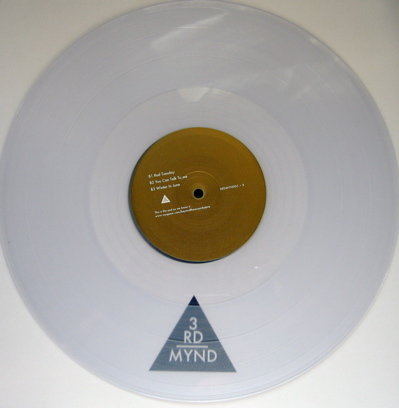
Beyond the Wizard's Sleeve, "West"
3rd Mynd
Although their name alternately suggests a Tolkien-inspired progressive rock group, or a tasteless pussy joke, Beyond the Wizard's Sleeve is actually an audacious musical hybrid that is much more tasteful than either of these two possible meanings would seem to indicate. BTWS is DJ/producer Erol Alkan working with Richard Norris, the experimental dance producer who was one-half of The Grid, and part of Psychic TV during the Jack the Tab years. Together, these two have birthed an entirely new genre, carefully editing and looping old psychedelic pop, mod and garage records from the 1960s into hypnotic, blissed out dancefloor anthems. In this, the Age of Recycled Culture, the idea of turning old freakbeat and krautrock records into repetitive, open-ended, mixable dance jams is one whose time has come. The rapturous hedonism created by these heady mixes is indescribable: a strange mixture of borrowed nostalgia and thrilling novelty. Dance music has always been psychedelic, and by literalizing the connection between 60s psychedelia and 00s club culture, Alkan and Norris outdo PTV at their own game. BTWS have been DJing parties for the past couple years, spinning sets that contain nary a track from the DFA or Ed Banger. Instead, you might hear an extended remix of The Rolling Stones' "2000 Light Years From Home," fading into a hallucinogenic reworking of The Hollies' "King Midas In Reverse," rubbing shoulders with a perversely retooled version of The Monkees' "Can You Dig It?" Because their music relies so heavily on old records—for which there can be no doubt that they have not received copyright clearance—their 12" EPs are released on the fly-by-night label 3rd Mynd, quickly going of print. This newest release contains six tracks of lysergic weirdness to make clubbers of all levels of intoxication see trails. The intro "Space" is a tape-delayed loop of William Shatner's opening monologue from the original Star Trek series, a deliciously campy way to kick things off. Things get further out with "Get Ready to Fly," which has an awesome swirling horn loop and typically starry-eyed vocals: "Get ready to fly/We'll see silver birds in the sky." On the b-side, "You Can Talk To Me" is a re-edit of The Beatles' "Hey Bulldog," emphasizing the jaunty rhythm section, looping John Lennon's vocals to raucous, anthemic effect. Free love, free acid and nouveau riche Euro club trash: this is the kind of party I want to be invited to.
sample:
 Hercules & Love Affair, "Blind"
Hercules & Love Affair, "Blind"
DFA
Hercules & Love Affair are a new signing to the DFA imprint, the work of Andy Butler, a house music classicist through and through. His previous 12" for DFA ("Classique #2") was a superlative exercise in purism: velvety basslines, crisp drum programming, and an atmospheric vocal refrain in the classic diva mold. The b-side ("Roar") was in the same vein, but a bit more maximalist, hard-hitting, and enlivened with a slight but unmistakable vocal contribution from one Antony Hegarty, queer troubador and perhaps the most sought-after guest vocalist after T-Pain. This new single is a teaser for the upcoming full-length album, containing three versions of "Blind," a song that dispenses with much of the house-style synthesis of "Classique #2" in order to go full-tilt disco. Butler approaches this sophisticated, downtown disco with the same determined purism that he approached house music with, creating a sparkling concoction of congos, handclaps, organic bass, shimmering synth arpeggiations, horn fanfares and a full vocal contribution from Antony. The lyrics have all the melodrama of a classic Sylvester side, with perhaps a bit more gay pathos: "As a child I knew, that the stars would only get brighter/And we would get closer/Leaving this darkness behind." The track is fabulously well-produced and unashamedly over-the-top. This CD single contains the album version of the track, an extended club mix that emphasizes the kicks and synth-lines, and an instrumental version. All this bodes very well for Butler's upcoming full-length, which has the potential to be one of the best albums released for DFA after a run of recent lackluster efforts from the likes of LCD Soundsystem, Black Dice and the Shocking Pinks. Hercules & Love Affair is the perfect addition to the DFA stable.
sample:
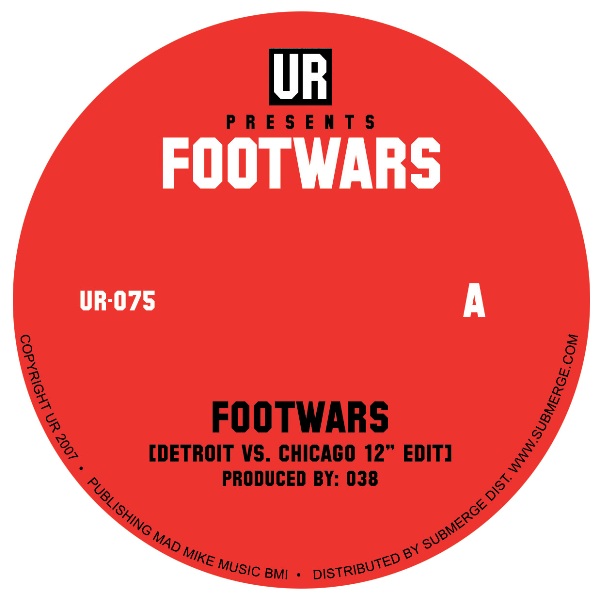 Underground Resistance, "Footwars"
Underground Resistance, "Footwars"
UR
The recent music issued from the UR camp has focused on organic, seemingly live percussion (no plasticated 909 thumps) forming the backbone for cannily constructed, uptempo tracks that finally stick their head out of the deep, dark subterranean hole in which the UR collective has been firmly ensconced for years. There's nothing subaquatic, scratchy or vague sounding about the main attraction on this recently issued 12", called "Detroit vs. Chicago." The song is all energy and bounce, almost lighthearted when compared to classic UR missives, which literalized the post-industrial wasteland of Detroit in audio form. Perhaps this is because the battle metaphor being employed here calls for something more extroverted and confrontational, rather than cerebral and withdrawn. Either way, this is a fucking ridiculously great slab of vinyl, pitting two long-standing dance cultures against each other, an insistent beat joined by an irresistable, badonka-donk bassline. Two small vocal snippets, neither of which I can decipher, form a call-and-response as the track unfolds, never afraid to push repetition to its limits, but always giving up the goods. The goods come in the form of some wicked samples that sound like an old car engine being forced to start against its will. The b-side contains two instrumental versions, perfect for creating your own mash-ups, or using as a backing track for a freestyle rap.
sample:
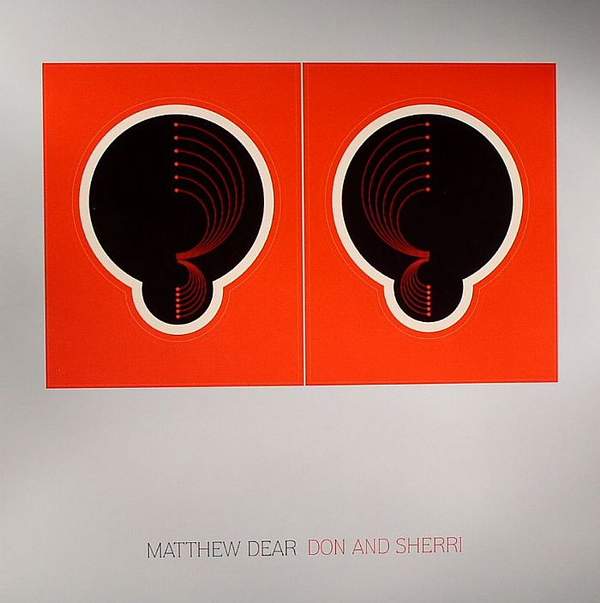 Matthew Dear, "Don and Sherri"
Matthew Dear, "Don and Sherri"
Ghostly International
Matthew Dear's Asa Breed was probably my favorite album of 2007. It was certainly the album I listened to the most, representing the perfect musical marriage of heaven and hell. Dear's intensely rendered machinic beat constructions, moody baritone vocals, dark grainy atmospheres and bizarrely out-of-tune instrumentation conspired to create one of the only albums I've ever heard that convincingly bridges the gap between cutting-edge techno and urbane pop. This 12" on Ghostly contains several versions of one of Asa Breed's standout tracks, the druggy, esoteric "Don and Sherri," a disorienting and queasy song that hits all the right notes, even as it utterly dislocates. The track seems ripe for the remix treatment, but only one of the versions included here arrive at worthwhile results. M.A.N.D.Y. attempts to rework the song into a variatinion on A Number of Names' "Sharevari." The attempt is admirable, but the penchant for whimsicality and eclecticism on the display do the track a disservice, and I can't imagine returning for another go-round. Hot Chip's remix, however, is stunning, upping the pop quotient by several degrees, foregrounding Dear's vocals and surrounding them with 10CC-style textural atmospherics and ethereal background vocals. An instrumental version of the Hot Chip remix is also included, nice but superfluous. The EP concludes with a DJ Koze remix of my favorite Asa Breed track, "Elementary Lover." By stripping away some of the grime from the track and constructing his own kitschy, cartoonish, technicolor backing for Dear's wry vocals, DJ Koze succeeds at completely recontextualizing the song, but in a way which never seems forced or false. I'm not sure if any of this stuff would work particularly well for any but the most adventurous, avant-garde DJ sets, but in my book, that's a positive.
sample:
 Fischerspooner, "The Best Revenge"
Fischerspooner, "The Best Revenge"
Kitsune Maison
Poor Fischerspooner: their sophomore album Odyssey tanked hard, unfavorably (and perhaps inevitably) compared to their breakthrough debut album. The accompanying tour was a study in failure, Messrs. Spooner and Fischer making the bonehead decision to forsake everything for which they were known: intensely visual live peformances, lip-syncing, synchronized dancing, costume changes and avant-garde theater tactics. In their place, all audiences got was the sneering, talentless Casey Spooner on an ego trip doing poorly rendered versions of FS songs with a live band. Mercifully, the tour was cancelled halfway through. It was a gamble that didn't pay off, not even slightly. No one goes to a Fischerspooner show expecting integrity and authenticity; they go because they want something gloriously superficial, outrageous and campy. I'm not sure if the existence of this new 12" single, recently released on the French Kitsune Maison label, is any indication that FS have been quietly and unceremoniously released from their major label contract, but you certainly couldn't blame Capitol for dropping them like a hot potato. In any case, this single sucks major ass, and sounds so phoned in that it might as well have been recorded on voice mail. Trading on the time-honored cliche that "the best revenge is living well," Spooner sings about his wealthy lifestyle over a plodding, overworked track that sounds like a Robert Palmer b-side from the mid-1980s, only not as fresh or clever. The extended, compression-house "Autokratz Righteous Retribution Mix" improves slightly upon its source material, by dispensing with the vocals, locating an actual "groove" and running with it. Alex Gopher's "Retaliation Remix" pushes the track into darker territory, a pulse-pounding rave-up complete with cheesy, dramatic breaks. It's not very good, I'm afraid, though it sure beats the original. I think that Fischerspooner should just quit while they're still behind, but since when has good judgment and restraint ever been a part of this project?
sample:
Read More
- Administrator
- Albums and Singles
 The stark packaging adorning this CD gives no hint of the majesty of David Jackman's latest drone opus. Omega marks the third and final instalment of a trilogy that started with Sanctus on Robot Records and continued with Amen, also on Die Stadt.
The stark packaging adorning this CD gives no hint of the majesty of David Jackman's latest drone opus. Omega marks the third and final instalment of a trilogy that started with Sanctus on Robot Records and continued with Amen, also on Die Stadt.
This is indeed an adventurous release, composed essentially of one lengthy organ (and what sounds like a sitar) drone track broken up into three equal segments of just over 15 minutes' duration each. For any fan of either Organum or drone epics then this is something of a treat: the use of the swirling organ—with occasional interjections of bass counterpoints—lends this an utterly uplifting and deeply spiritual, sacral, and contemplative quality. This does indeed sound as if an organ from some huge cathedral or grotto was employed in its creation; the overall effect is one of vast spaces being filled with the music, all the while resonating with and echoing off of centuries-old stone edifices. Simultaneously the organ also invests the track with a warmth and closeness that made me want to wrap myself in it—this whole piece felt like an all-enveloping blanket of reassuring sound. As a consequence this is definitely one of those releases that seemingly not only gets into the brain to stimulate the intellectual and spiritual centers but also has the capacity to resonate at the physical level too; I almost expected my diaphragm and brain to start vibrating in sympathy with it, such is the depth and strength of the music and the bass drones.
It seems almost profane to describe Omega in any way other than spiritual or sacral. This could possibly be classified as a reinvigoration of sacred English and European baroque church music of which this seems to be an heir, with both a reinterpretation of that style and a re-alignment in conformation to a 21st century aesthetic. Although in many ways it could be argued that this is quite static and fails to evolve over the entire 45 minute length. I don't think that that's the point here; in combination with that uplifting quality I spoke of previously there is also a sublime sense of timelessness evident, almost verging on the eternal—almost as if once started then it will continue forever, until indeed the universe attains its own ultimate omega. Just like there are always beginnings somewhere out there in the limitless universe, so too there are endings—and this is a beautifully uplifting rendering of those very eternally-occurring endings (omegas).
(As an aside, after having listened to this about three or four times continuously, I felt slightly light-headed - I wonder if it was because of the effect the music was having on me...)
Samples:
Read More
- Administrator
- Albums and Singles
 Attention American Idol contestants! Luigi Tenco failed to make the final of the 1967 San Remo Festival. As a protest against the jury's taste in music, he shot himself in the head. The song Tenco performed was "Ciao Amore Ciao" and had I been judging he would still have pulled the trigger. However....
Attention American Idol contestants! Luigi Tenco failed to make the final of the 1967 San Remo Festival. As a protest against the jury's taste in music, he shot himself in the head. The song Tenco performed was "Ciao Amore Ciao" and had I been judging he would still have pulled the trigger. However....
Luigi Tenco's best work is quite magnificent. His "Lontano Lontano" puts romance in the context of a human lifespan, with irony, regret, and a kind of ecstatic madness. The song is a delicate balance of agony, joy, and sadness with its irresistible opening lines setting the tone: "And one day a long, long, time from now, you'll see something in the eyes of somebody/And that something will remind you of me, and my eyes that once loved you so much."
Steven Brown formed Tuxedomoon in San Francisco in 1977 and the group released several records on the Residents' Ralph label. They relocated to Europe and that is probably where he discovered the recordings of Luigi Tenco. Brown's thoroughly convincing version of Tenco's material, in both English and Italian, has an air of tragedy and the wistful quality of a slightly unhinged Bowie. His view of "Ciao Amore Ciao" is almost the exact opposite of mine but we arrive at the same conclusion: "On one level it sounds like a rock ballad, but when you listen to the lyrics (and the delivery of those lyrics) this song pulls itself into another realm altogether; behind the veneer behind the gloss into yourself. If that had been the only Tenco song I ever heard, it would have been enough."
After playing in high school jazz bands, Tenco played professionally with I Cavaieri (The Knights) under the pseudonym Gigi Mai. In 1961 he issued "Quando," the first single under his real name and a little later he also flirted with acting and soundtrack music. After military service he signed with RCA and in 1966 released the wonderful "Un Giorno Dopo L'Altro" (One Day After Another). That same year Tenco fell in love with Italo-French singer Dalida. Perhaps against his will, the two performed at San Remo. On January 27, 1967 she found him dead in his hotel room, bullet wound in his left temple, suicide note nearby. Tenco and Dalida had become engaged just a few days earlier. Apparently the judges downplayed his death and the contest continued. Ah showbiz!
The backing on most of these tracks is terrific with suitably sparse piano, saxophone, double bass, clarinet, flute and light percussion. Five pieces are a re-release of a 1988 mini-album originally issued on the Industrie Discographiche Lacerba label. The 12 additional songs include Brown solo material ("Besides All That," "R.W.F.") several Tuxedomoon tracks such as "What Use?," and some interesting live recordings. All this make Brown Plays Tenco a consistent and appealing record.
samples:
Read More
- Administrator
- Albums and Singles
 After a prolonged absence, Italy's Eidvlon re-emerge into the harsh light of day for the first time in seven years with Idolatriae, a heavy trove of dark mutterings and arcane rumblings extracted from the deepest recesses of both the human psyche and the dankest caverns of earth.
After a prolonged absence, Italy's Eidvlon re-emerge into the harsh light of day for the first time in seven years with Idolatriae, a heavy trove of dark mutterings and arcane rumblings extracted from the deepest recesses of both the human psyche and the dankest caverns of earth.
Francesco Gemelli, the High Priest of these hidden currents, leads a guided sonic exploratory tour of the dark occult catacomb spaces of the world where the shades of the dead wander aimlessly through barren landscapes, a place where even spirit no longer sheds its numinous light. EIDVLON is a Greek word denoting an insubstantial shade, an image that possesses no depth; Gemelli here uses it as a pejorative, applying it to the empty spirituality of the modern world, where the substituting of the idols of materialistic culture for the spiritual values inherent in the quest for the occult and spiritual is now a commonplace; where even the major religions have become nothing more than items in the superstore of beliefs, where the potential adherent can pick and choose a nice cosy belief-system to suit his/her needs and preferences. The spiritual landscape is bleak and uninviting to those who hear the true seeker's call; inevitably they must pass on to other pastures.
Consequently, Gemelli utilises the bleakest and darkest of catacomb sounds to describe this hollowness of the soul, where the spirit constantly mourns for the loss of its supremacy among the milling masses; the sounds appear to have been seemingly dragged from the belly of the beast itself. Granular crackling, the tolling of bells, tectonic crunches, subterranean rumblings, slow pounding reverb-soaked percussion, the lowest of prolonged bass grumblings and drones—these are the elements that Gemmelli conjures with to bring us his pessimistic vision of the slow ritualistic death of the soul and the supercession of the materialistic. The atmosphere is heavy and bleakly oppressive; it feels as if the velvet cloak of darkness abounding is completely impenetrable, and should any sliver of light dare to show itself it will be immediately snuffed out of existence. This is where hope ends and darkness begins.
For me, one of the strengths of this album is its very pessimism and cloyingly claustrophobic atmosphere, plus the sentiments expressed here tally quite closely with my own views on the subject; moreover Gemelli's use of his material expresses fully and clearly the ideas he intends to convey. He drags us down into the depths of the subterranean void to become participants in and witnesses to that final extinguishing of the light.
Samples:
Read More

